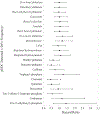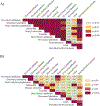Firefighter exposures to potential endocrine disrupting chemicals measured by military-style silicone dog tags
- PMID: 34649051
- PMCID: PMC8757287
- DOI: 10.1016/j.envint.2021.106914
Firefighter exposures to potential endocrine disrupting chemicals measured by military-style silicone dog tags
Abstract
Studies suggest that exposure to potential endocrine disrupting chemicals (pEDCs) may contribute to adverse health outcomes, but pEDC exposures among firefighters have not been fully characterized. Previously, we demonstrated the military-style silicone dog tag as a personal passive sampling device for assessing polycyclic aromatic hydrocarbon exposures among structural firefighters. This follow-up analysis examined the pEDC exposures based on department call volume, duty shift, and questionnaire variables. Structural firefighters (n = 56) were from one high and one low fire call volume department (Kansas City, MO metropolitan area) and wore separate dog tags while on- and off-duty (ndogtags = 110). The targeted 1530 analyte semi-quantitative screening method was conducted using gas chromatography mass spectrometry (npEDCs = 433). A total of 47 pEDCs were detected, and several less-frequently-detected pEDCs (<75%) were more commonly detected in off- compared to on-duty dog tags (conditional logistic regression). Of the 11 phthalates and fragrances detected most frequently (>75%), off-duty pEDC concentrations were strongly correlated (r = 0.31-0.82, p < 0.05), suggesting co-applications of phthalates and fragrances in consumer products. Questionnaire variables of "regular use of conventional cleaning products" and "fireplace in the home" were associated with select elevated pEDC concentrations by duty shift (paired t-test). This suggested researchers should include detailed questions about consumer product use and home environment when examining personal pEDC exposures.
Keywords: Firefighter; Passive sampling; Personal monitoring; Potential endocrine disrupting chemical.
Copyright © 2021 The Authors. Published by Elsevier Ltd.. All rights reserved.
Conflict of interest statement
Declaration of Competing Interest
The authors declare the following financial interests/personal relationships which may be considered as potential competing interests: Kim A. Anderson, an author of this research, discloses a financial interest in MyExposome, Inc., which is marketing products related to the research being reported. The terms of this arrangement have been reviewed and approved by OSU in accordance with its policy on research conflicts of interest. The authors have no other disclosures.
Figures



References
-
- Al-Saleh I, Elkhatib R, 2016. Screening of phthalate esters in 47 branded perfumes. Environ. Sci. Pollut. Res 23 (1), 455–468. - PubMed
-
- Alexander BM, Baxter CS, 2014. Plasticizer contamination of firefighter personal protective clothing: a potential factor in increased health risks in firefighters. J. Occup. Environ. Hyg 11 (5), D43–D48. - PubMed
-
- Balci E, Genisoglu M, Sofuoglu SC, Sofuoglu A, 2020. Indoor air partitioning of synthetic musk compounds: gas, particulate matter, house dust, and window film. Sci. Total Environ 729, 138798. - PubMed
Publication types
MeSH terms
Substances
Grants and funding
LinkOut - more resources
Full Text Sources
Medical
Miscellaneous

